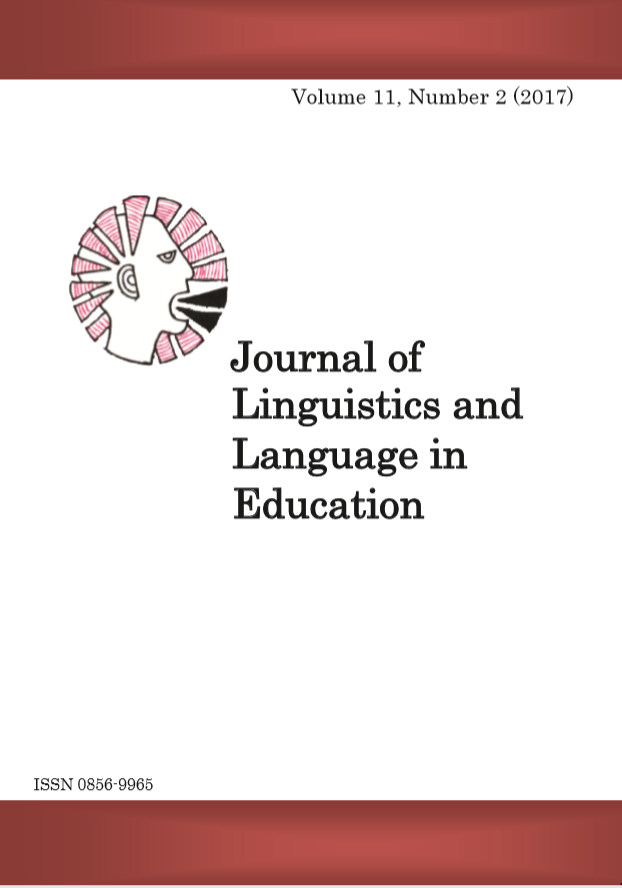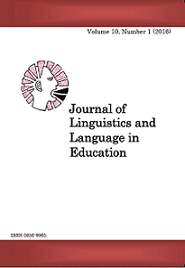Repetition in University Classroom Interaction: A Case Study of the University of Dar es Salaam
Abstract
This paper investigates how lecturers use repetition to perform different functions during classroom interaction at the University of Dar es Salaam. The data encompass eight recorded lectures and interviews with the respective lecturers teaching first year students in the Departments of Political Sciences and Public Administration and Sociology and Social Anthropology. The objective is to identify, describe and analyse how lecturers apply repetition as a communication strategy to convey information at a sophisticated level of academic rhetoric to facilitate knowledge delivery. Discourse analysis (DA) approach facilitated the identification and analysis of repetition as a discourse strategy of lecturers, and as part of spoken registers that are generically used in university teaching in Tanzania. The findings indicate that lecturers used phrasal and clausal types of repetition to
achieve cohesion, topic continuity and emphasis. This paper extends knowledge on how multilingual speakers utilise various techniques in facilitating delivery and understanding of knowledge.
Key words: discourse analysis, discourse strategy, repetition, lectures,
lecturers
References
Allwood, J., Nivre, J. & Ahlsén, E. (1990). Speech Management on
the Non-written Life of Speech. Nordic Journal of Linguistics, 13(1): 1 €“45.
Biber, D. (2006). University Language: A Corpus-based Study of
Spoken and Written Registers. Amsterdam: John Benjamins.
Björkman, B. (2011). Pragmatic Strategies in English as an
Academic Lingua Franca: Ways of Achieving Communicative Cffectiveness? Journal of Pragmatics, 43(4): 950 €“964.
De Fina, A. & Johnston, B. (2015). Discourse Analysis and Narrative.
In D. Tannen, H. E. Hamilton & D. Schiffrin (eds.).The Handbook of Discourse Analysis (2nd ed.). West Sussex: Wiley Blackwell: 153 €“167.
De Fina, A. & Johnstone, B. (2015). Discourse Analysis and
Narrative. In D. Tannen, H. E. Hamilton & D. Schiffrin (eds.).
The Handbook of Discourse Analysis (2nd ed.). West Sussex: John Wiley & Sons: 152 €“167.
Dörnyei, Z. & Scott, M. L. (1997). Communication Strategies in a
Second Language: Definitions and Taxonomies. Language
Learning, 47 (1): 173 €“210.
Fung, L. (2007). The Communicative Role of Self-repetition in a
Specialised Corpus of Business Discourse. Language Awareness, 16(3): 224 €“238.
Genç, B., Marasoglu, M. & Bada, E. (2009). Types and Functions of
Repetitions in the Narrations of Turkish Speakers of French.
Novitas-ROYAL: Research on Youth and Language, 4(2): 216 €“224.
Guo, Hua. (2017). Free Indirect Thought in Stream-of-Consciousness
Fiction: A Textural Cohesive Perspective. International Journal of English Linguistics, 7(6): 38 €“46.
Guo, H. (2017). Free Indirect Thought in Stream-of-Consciousness
Fiction: A Textural Cohesive Perspective. International Journal of English Linguistics, 7(6): 38 €“46.
He, Q. (2014). Implication of Lexical Repetition to Teaching.
Interacional Journal of Linguistics, 6(4): 46 €“58.
Hsieh, F. (2011). Repetition in Social Interaction : A Case Study on
Mandarin Conversations. International Journal on Asian Language Processing, 19(4): 153 €“168.
Jenkins, J. (2009). English as a Lingua Franca: Interpretations and
Attitudes. World Englishes, 28(2): 200 €“207.
Johnstone, B. (1994). Repetition in Discourse: A Dialogue. In B.
Johnstone (ed.). Repetition in Discourse: Interdisciplinary Perspectives, 1: 1 €“20.
Kaur, Jagdish. (2012). Saying it again: Enhancing Clarity in English
as Lingua Franca (ELF) Talk through Self-repetition, Text &
Talk, 32(5): 593 €“ 613.
Kaur, J. (2010). Achieving Mutual Understanding in World Englishes. World Englishes, 29(2): 192 €“208.
Kachru, B. B. (1998). English as an Asian Language. Links and
Letters, (5): 89 €“108.
Knutson, E. (2010). Repetition as Response in Conversational
Interaction and Language Learning. The NECTFL Review, (66):14 €“29.
Leftein, A. & Snell, J. (2011). Promises and Problems of Teaching
with Popular Culture: A Linguistic Ethnographic Analysis of Discourse Genre Mixing in Literacy Lesson. Reading Research Quarterly, 46(1): 40 €“69.
Mwinsheikhe, H. M. (2009). Spare no Means: Battling with the
English/Kiswahili Dilemma in Tanzanian Secondary School Classrooms. In B. Brock-Utne & I. Skattum (eds.). Languages and Education in Africa: A Comparative and Transdisciplinary Analysis. Bristol Papers in Education. Number 4. Symposium Books.
Norrick, N. N. (1987). Functions of Repetition in Conversation. Text,
(3): 245 €“264.
Qorro, M. (2006). Testing Students ' Ability to Learn through English
during the Transition from Primary to Secondary Schooling. In B. Brock-Utne, B. M. Qorro & Z. Desai (eds.). Focus on Fresh
Data on the Language of Instruction Debate in Tanzania and
South Africa. Cape Town: African Minds.
Quick, P. (2007). Resumptive Repetition: Introduction to a Universal
Discourse Feature. LINGUISTIKA, 14(26): 1 €“15.
Rabab'ah, G. & Farhan, A. A. (2012). The Pragmatic Functions of
Repetition in TV Discourse. Research in Language, 10(4): 442 €“460.
Rubagumya, C. M. (2008). Going through the Motions of Learning:
Classroom Interaction in Tanzania. In B. Brock-Utne, Z. Desai & M. Qorro (eds.). LOITASA: Reflecting on Phase I and Entering Phase II: 143 €“159.
Shartiely, N. E. (2013). Discourse Strategies of Lecturers in Higher
Education Classroom Interaction: A Case at the University of Dar es Salaam, Tanzania. Unpublished PhD Thesis, University of Stellenbosch.
Sidtis, V. D. & Wolf, R. (2015). Pragmatic Verbal Repetition: Review and Application of a New Method of Quantification. Text and Talk: 1 €“25.
Steeb, M. (2008). Discourse Functions of Right-dislocated Repetition and other Repetition Structures in Khmu Oral Narratives. Payap
University, April 2008.
Tang, C. (2015). Applications of Stalling Mechanisms in Chinese-
English Bilinguals ' L1 and L2 Spoken Discourse. International Journal of Bilingualism, 19(1): 92 €“114.
Tannen, D. (1987). Repetition and Poetics of Talk. Language, 63(3):
€“605.
Tannen, D. (1991). Talking Voices: Repetition, Dialogue and Imagery in Conversational Discourse. Cambridge: CUP.
Tannen, D. (2007). Talking Voices (2nd edn.). Cambridge: CUP.
Urmeneta, Escobar Christina. (2013). Learning to Become a CLIL
Teacher: Teaching, Reflection and Professional Development.
International Journal of Bilingual Education and Bilingualism, 16(3): 334 €“353.
Viano, D. M. M. & Conejos, P. G. (1996). Communicative Functions of
Repetition in Classroom Interaction. Research in Second Language Acquisition, 11: 129 €“141.
Watterson, M. (2008). Repair of Non-understanding in English in
International Communication. World Englishes, 27(3 €“4): 378 €“406.
Yemeniçi, A. 2002. Categories and Functions of Repetition in Turkish
Oral Narratives. Boğaziçi University Journal of Education,
(1): 13 €“35.
Downloads
Published
Issue
Section
License
Copyright © by Department of Foreign Languages and Linguistics, University of Dar es Salaam
All rights reserved. No part of this publication may be reproduced or transmitted in any form or by any means, electronic or mechanical, including photocopying, recording, or any information storage or retrieval system, without permission in writing from the publisher, except for short extracts in fair dealing, for research or private study, critical scholarly review or discourse with an acknowledgement.



